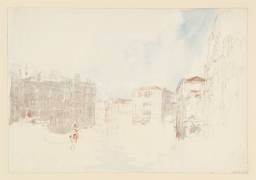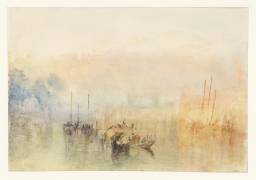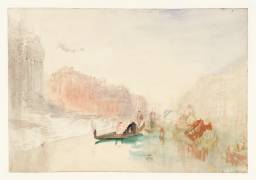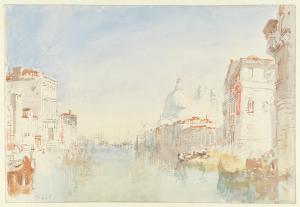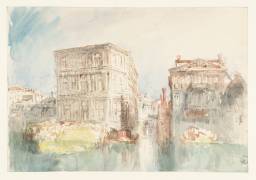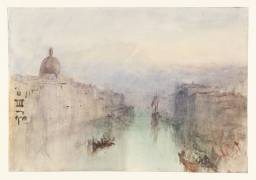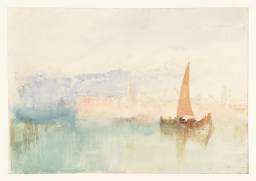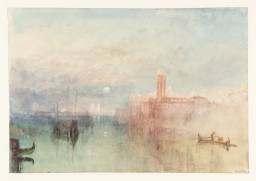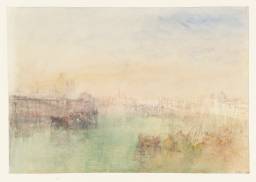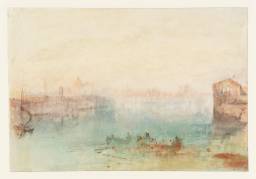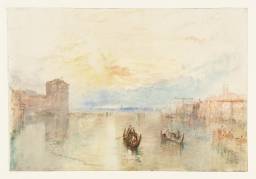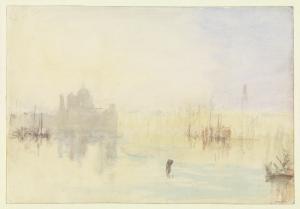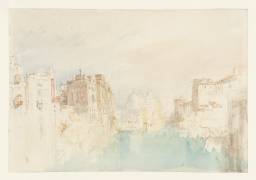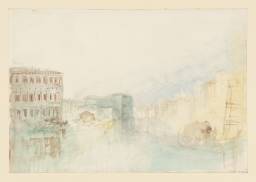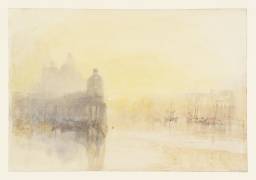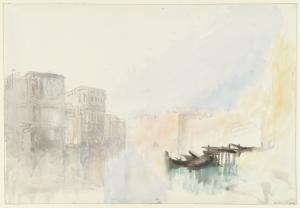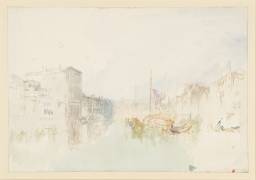Turner Bequest CCCXV 1–21, CCCXVI 41
22 leaves from a disbound ‘roll’ sketchbook (or possibly from two similar books; see main catalogue entry), originally bound in covers of lightweight wove paper, marbled with irregular, rippled diagonal pattern in grey, with veins in white and touches of yellow, blue and dark pink (outer faces not accessioned), laminated over endpapers (D41533–D41534)
Endpapers and separated leaves of white wove paper, page size approximately 220 x 320 mm
Maker unidentified; numerous leaves watermarked ‘J Whatman | 1834’
Printed label of Roberson (sic) and Miller, London, inside back cover (D41533)
Stamped in black ‘CCCXV’ towards top right of front cover
Endpapers and separated leaves of white wove paper, page size approximately 220 x 320 mm
Maker unidentified; numerous leaves watermarked ‘J Whatman | 1834’
Printed label of Roberson (sic) and Miller, London, inside back cover (D41533)
Stamped in black ‘CCCXV’ towards top right of front cover
Accepted by the nation as part of the Turner Bequest 1856
References
Twenty-one of these twenty-two separate watercolours on 1834 Whatman paper,1 presented here as the contents of a single sketchbook, were described by Finberg as having constituted what he prosaically called a ‘Roll Sketch Book of Venice’.2 For the Turner and Venice exhibition of 2003, Ian Warrell recast them as the ‘Grand Canal and Giudecca’ sketchbook, giving a flavour of their subject matter as a notional ‘journey through the centre of Venice, and then away to its unfamiliar western edges’,3 together with Tate D32178 (Turner Bequest CCCXVI 41),4 from Finberg’s category of Venice subjects on miscellaneous white papers.5 Warrell had previously proposed linking D32178 with the others here on the grounds of its comparable style and the similarity of its paper, which would also resolve the discrepancy between Finberg’s 1909 Inventory listing and John Ruskin’s original endorsement: ‘13. Book of 22 coloured sketches of Venice’.6
Finberg had noted without further comment that the ‘leaves were all distributed and unnumbered’.7 Ten sheets were shown in the early National Gallery displays from the Bequest (D32120–D32129; Turner Bequest CCCXV 4–13), described in Ruskin’s 1857 commentary as ‘leaves of one drawing-book, apparently consecutive, and made in the course of two or three days’.8 This ‘apparently’ is ambiguous and perhaps evasive, leaving it unclear as to whether Ruskin had seen the sketchbook intact, found the drawings separated but perhaps held in sequence within the surviving paper covers, or took the book apart himself, phrasing his comment as a convenient means of creating a loose narrative from the disparate subjects and treatments.
Finberg later attempted to characterise the whole sequence as reconstructed in 1909: ‘The pencil outlines only – generally very slight and summary – were done from nature; the colouring was done afterwards from memory.’9 The perennial issue of determining how much if any of Turner’s colour was applied in particular instances ‘on the spot’ or subsequently10 arises here given the varying degrees of finish and development, and the presence or absence of pencil outlines of varying degrees of detail. John Gage considered that for example ‘pp. [CCCXV] 18–21 [D32134–D32137] are in a muted range of greens and browns which seem to come from a direct experience of the subject, while pp. 11–14 [D32127–D32130] have a far more complex technique and brilliant colouring’, proposing that ‘perhaps both modes were used interchangeably for indoor work.’11 Sam Smiles has suggested that the more ‘summary studies of light and architecture’ among the leaves here show the possibility that ‘even in the last decade of his career Turner was still prepared to sketch [in colour] in the open air’.12
Some nineteen technically comparable Venice watercolours in other collections are on 1834 Whatman paper of the same format (see the checklist below). In various texts relating to individual examples, commentators had suggested that they had once been part of the present sketchbook, or one or more much like it,13 and that some at least had been sold through Turner’s agent in later years, Thomas Griffith,14 in the absence of formal commissions for finished Venice watercolours.15 Regarding the sheet now known as Storm at Venice (British Museum, London), Andrew Wilton observed that it was ‘one of a group of drawings executed in a similar style, and all showing scenes of storm’, using the last word twice more in inverted commas in the same context, and dating them all to 1840.16 Subsequently, noting that ‘few of Turner’s late roll sketchbooks contained more than twenty-four sheets’,17 Warrell proposed that just one other book made up of the same 1834 Whatman paper accompanied the artist to Venice from London, naming it the ‘Storm’ sketchbook.18 He suggested that the ‘generally more developed’ watercolour compositions,19 long dispersed beyond the Turner Bequest, were those broken up and sold by Griffith from this second book, likely still with him at Turner’s death;20 several were owned by Ruskin (as noted in the checklists below).21
Referring subsequently to the present leaves as from a less specifically titled ‘Venice’ sketchbook, Warrell has observed that his binary solution had been effected ‘to make a simple distinction’, and in practice the pages ‘would have been intermixed, with Turner painting variations on the same motifs on successive pages’.22 Nevertheless, it remains convenient for cataloguing purposes to retain the division between the present ‘sketchbook’ and the ‘Storm’ leaves scattered elsewhere, especially as the original arrangement of the surviving total of forty-one leaves and thus the phases of Turner’s work on them are irrecoverable.
The Turner Bequest ‘Grand Canal and Giudecca’ subjects catalogued here comprise three aspects of Venice as seen from its waterways. Notionally running north-west to south-east between the churches of San Simeone Piccolo and Santa Maria della Salute via the Rialto Bridge, the Grand Canal subjects are D32124, D32135, D32178, D32132, D32119, D32118, D32137, D32123, D32117, D32136, D32134, D32131, D32122 and D32121 (CCCXV 8, 19, CCCXVI 41, CCCXV 16, 3, 2, 21, 7, 1, 20, 18, 15, 6, 5). From the broad waters of the Bacino beyond the Salute, D32120, D32130 and D32133 (CCCXV 4, 14, 17) look west to its domes and the entrance to the Grand Canal. Meanwhile, D32125–D32129 (CCCXV 9–13) form a distinct grouping from viewpoints towards the western end of the Canale della Giudecca (or likely in the vicinity), at a remove from the centre of the city. There are comparable 1840 watercolour subjects on other papers in the parallel, topographically arranged subsections of this tour.
Complementing the present ‘Grand Canal and Giudecca’ grouping, the nineteen dispersed ‘Storm’ leaves are listed below in the established order of Wilton’s general catalogue of Turner’s watercolours (which omitted the last three), where they are interspersed with other Venice subjects. Titles are as given in Warrell’s Turner and Venice, with the reproductions there and in Lindsay Stainton’s Turner’s Venice noted. The less detailed titles are supplemented by brief remarks on setting and conditions:
Lightning in the Piazzetta (National Gallery of Scotland, Edinburgh):23 from the Molo; the only view without water in the foreground, and effectively a nocturnal subject
Storm at Sunset (Fitzwilliam Museum, Cambridge, gift of John Ruskin):24 looking north across the Bacino from the Canale della Grazia, near San Giorgio Maggiore
Storm at Venice (British Museum, London):25 indistinct, rain-filled view northwards from around the entrance to the Grand Canal
Venice: Looking towards the Dogana and San Giorgio Maggiore, with a Storm Approaching (private collection):26 from the eastern end of the Canale della Giudecca
Storm at the Mouth of the Grand Canal (National Gallery of Ireland, Dublin):27 looking east to San Giorgio Maggiore
View down the Grand Canal towards the Dogana and the Campanile of San Marco (British Museum, London):28 clear, perhaps with some distant cloud
The Mouth of the Grand Canal (Yale Center for British Art, New Haven):29 looking east to the Dogana; calm, hazy
Calm at Sunrise (Looking towards San Giorgio and the Salute) (Fitzwilliam Museum, Cambridge, gift of John Ruskin):30 west from the Canale di San Marco
The Grand Canal, with the Salute (Ashmolean Museum, Oxford, gift of John Ruskin):31 looking east to the Dogana; clear
Venice: The Riva degli Schiavoni (Ashmolean Museum, gift of John Ruskin):32 from the Bacino; calm, sunlit
The Accademia from the Grand Canal (Ashmolean Museum, gift of John Ruskin):33 calm, sunlit
The Grand Canal, with Santa Maria della Salute, from near the Hotel Europa (private collection):34 looking west around sunset, with cloud building or clearing
The North-Western Façade of Santa Maria della Salute, Seen from the Grand Canal (National Gallery of Scotland):35 calm, sunlit
A Steamer Seen across the Lagoon (National Gallery of Scotland):36 storm, with indistinct sunlit distance
The Doge’s Palace from the Bacino (Walker Art Gallery, Liverpool):37 calm, sunlit
The Sun of Venice: Bragozzi Moored off the Riva degli Schiavoni (National Gallery of Scotland):38 calm, with the domes of the Salute silhouetted against clear sky to the west
San Giorgio Maggiore at Sunset (private collection):39 clear, largely still sunlit
Venice from the Punta della Dogana (private collection):40 hazy, with distant pink cloud
The Grand Canal (Perhaps Looking to Ca’ Grande) (currently untraced):41 clear, sunlit
In making various crucial technical links between the papers of various types used both in Venice and for subjects on the wider 1840 European itinerary (see the tour’s Introduction), Cecilia Powell observed that Turner used another ‘roll’ book of British manufacture, now known as the Passau and Burg Hals sketchbook (Tate; Turner Bequest CCCXL) for watercolour studies on the way back through Germany,42 with ‘marked similarities of style, colour and technique’43 to those grouped here.
For convenience, ten further dispersed Venice watercolours on various papers but all now associated with the 1840 tour are also listed here (again under Warrell’s 2003 titles, except the first), making twenty-nine in all outside the Bequest:
Shipping, with Buildings, ?Venice (Fitzwilliam Museum, Cambridge): Bally, Ellen and Steart grey wove paper44
The Doge’s Palace and the Piazzetta (National Gallery of Ireland, Dublin); ?Charles Ansell 1828 white wove paper45
San Giorgio Maggiore at Sunset (National Gallery of Ireland, Dublin); white wove paper46
Between the Giudecca and the Isola di San Giorgio, with the Bacino di San Marco (Fitzwilliam Museum, gift of John Ruskin): pale buff wove paper watermarked ‘J W’ (possibly Austrian imitation/forgery of Whatman paper)47
The New Moon (the Punta della Dogana, with the Zitelle Beyond (private collection); ?Charles Ansell 1828 white wove paper48
San Giorgio Maggiore and the Zitelle from the Giudecca Canal (private collection; possibly 1833): Bally, Ellen and Steart grey wove paper49
The Rialto Bridge from the North (National Gallery of Scotland, Edinburgh): pale buff wove paper watermarked ‘J W’50
Palazzo Balbi on the Grand Canal (National Gallery of Scotland): pale buff wove paper watermarked ‘J W’51
San Giorgio Maggiore from the Hotel Europa, at the Entrance to the Grand Canal (Whitworth Art Gallery, Manchester): white wove paper, probably made by Charles Ansell52
The Doge’s Palace from the Bacino (private collection; possibly 1833): Bally, Ellen and Steart grey wove paper53
See Finberg 1909, II, p.1016, Wilton 1974, p.154, Wilton 1975, p.134, Wilton 1979, p.462, Upstone 1993, p.39, and Warrell 2003, p.258.
See British Museum 1966, p.[8], Herrmann 1968, pp.83–4, Wilton 1974, p.156, Cormack 1975, p.66, Wilton 1979, p.462, Stainton 1985, pp.53–4, 60, 64, Wilton 1987, p.208, Milner 1990, p.62, Campbell 1993, p.81, Herrmann 2001, p.362, and Wilton 2006, p.242.
Wilton 1979, p.463 no.1352, reproduced; Stainton 1985, p.65 no.88, pl.88 (colour); Warrell 2003, fig.114 (colour).
Wilton 1979, p.463 no.1353, reproduced; Stainton 1985, p.64 no.86, pl.86 (colour); Warrell 2003, fig.253 (colour).
Wilton 1979, p.463 no.1354, reproduced; Stainton 1985, pp.64–5 no.87, pl.87 (colour); Warrell 2003, fig.188 (colour).
Wilton 1979, p.463 no.1358, reproduced; Stainton 1985, p.62 no.80, pl.80 (colour); Warrell 2003, fig.186 (colour).
Wilton 1979, p.463 no.1359, reproduced; Stainton 1985, p.61 no.73, pl.73 (colour); Warrell 2003, fig.181 (colour).
Wilton 1979, p.464 no.1361, reproduced; Stainton 1985, pp.59–60 no.68, pl.68 (colour); Warrell 2003, fig.219 (colour).
Wilton 1979, p.464 no.1363, reproduced; Stainton 1985, p.66 no.93, pl.93 (colour); Warrell 2003, fig.177 (colour).
Wilton 1979, p.464 no.1364, reproduced; Stainton 1985, p.60 no.69, pl.69 (colour); Warrell 2003, fig.239 (colour).
Wilton 1979, p.464 no.1366, reproduced; Stainton 1985, p.66 no.91, pl.91 (colour); Warrell 2003, fig.173 (colour).
Wilton 1979, p.464 no.1368; Stainton 1985, p.66 no.94, pl.94 (colour); Warrell 2003, fig.183 (colour).
Wilton 1979, p.464 no.1370, reproduced; Stainton 1985, p.66 no.92, pl.92 (colour); Warrell 2003, fig.179 (colour).
Wilton 1979, pp.464–5 no.1371, reproduced; Stainton 1985, p.65 no.89, pl.89 (colour); Warrell 2003, fig.255 (colour).
Wilton 1979, p.465 no.1374, pl.233; Stainton 1985, p.67 no.95, pl.95 (colour); Warrell 2003, fig.244 (colour).
Wilton 1979, p.463 no.1356, reproduced; Stainton 1985, p.65 no.90, pl.90 (colour); Warrell 2003, p.259, section 2, fig.235 (colour).
Wilton 1979, p.463 no.1357, reproduced; Stainton 1985, p.62 no.76, pl.76 (colour); Warrell 2003, fig.218 (colour), but not listed in ‘Appendix’, pp.258–9.
Technical notes
How to cite
Matthew Imms, ‘Grand Canal and Giudecca Sketchbook 1840’, sketchbook, September 2018, in David Blayney Brown (ed.), J.M.W. Turner: Sketchbooks, Drawings and Watercolours, Tate Research Publication, December 2019, https://www

